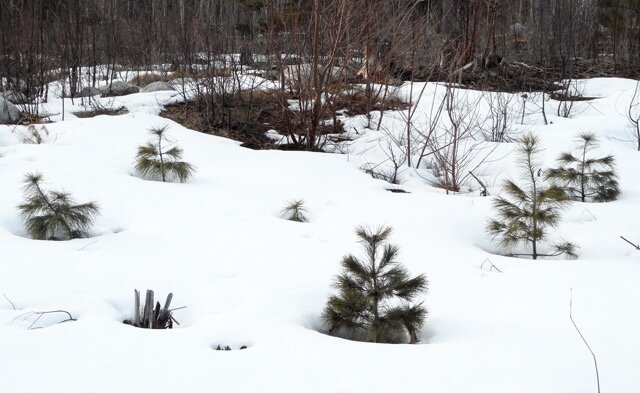Spring a Good Time for Tree Investigations
by Maxwell McCormack
The transition from winter into spring provides a special window of opportunity for reinforcing connections with our woodlots. The clear visibility of tree crowns and stand structure enjoyed during winter remain, while the melting snow accentuates ground conditions. The opportunity is lost after fresh spring growth fills the understory and crown foliage obscures the upper strata.
Red Maple (Acer rubrum)
Enjoy wildflowers along the forest floor and look up for the emerging catkins of the male poplar trees. Tree flowers tend to occur during the latter part of spring, but keep an eye out for them as you pass by emerging growth. Pull down a limb of red maple (Acer rubrum) for a closer look at their showy flowers (See photo). Often, casual observers dismiss them as breaking vegetative buds, but with a hand lens you can see a colorful display of nature’s magic.
Along brushy margins of forest growth take advantage of the early flushing buds of honeysuckles – four species of which are on Maine’s list of 33 most unwanted invasive plants. Their early showing of green distinguishes them from the other woody shrub species that remain dormant for a longer period. If there’s any doubt, check a few clipped branches for proof positive; honeysuckles have hollow pith.
Since the honeysuckle leaves precede the emergence of foliage of surrounding plants, some landowners hope to achieve selective control with an early spring application of glyphosate. I suspect such treatments can suppress the honeysuckle, but elimination is unlikely. It’s better to mark the identified plants to facilitate their location for effective treatment later in the growing season.
While partial snow cover remains and there is not yet grass or green broadleaf foliage, it’s a good time to assess conifer regeneration. The green needles are easy to spot and, where thin snow cover persists, protruding leaders are clearly visible (Second photo). By late spring these regeneration areas take on distinctly different appearances as small seedlings are obscured by a chaotic, leafy jumble.
Conifer regeneration. Protruding leaders are clearly visible.
Young White Pine (Pinus strobus) with a damaged leader
Stump of a tipped over spruce (Picea glauca)
During these early reviews, winter damage to young trees is plainly evident. The third photo shows a young white pine (Pinus strobus) with a damaged leader. In this case, where a second leader had started to form, a quick, remedial action is possible by trimming out the broken portion to favor the replacement. This is a good example of why you should carry an anvil-type hand pruner when you are walking through your woodlots.
Partial autopsies can be conducted to provide better understanding of stem failures. The final photo illustrates the stump of a tipped over spruce (Picea glauca) that appeared to have a sound merchantable butt log. Investigation of the stump uncovered heavy insect damage and dead roots on the failed side of the tree. The tree had no secure support or anchorage on the side that gave way when the crown became burdened with an overload of heavy, wet snow. The subsequent woodpecker activity was a spontaneous emphasis of the insect presence.
The foregoing illustrations are a few of the possible assessments that are easily made during an early spring woodlot review. The timing provides unique visibility conditions for you to keep in touch with the dynamic flow of events that occur in your ever-changing woodlands.




